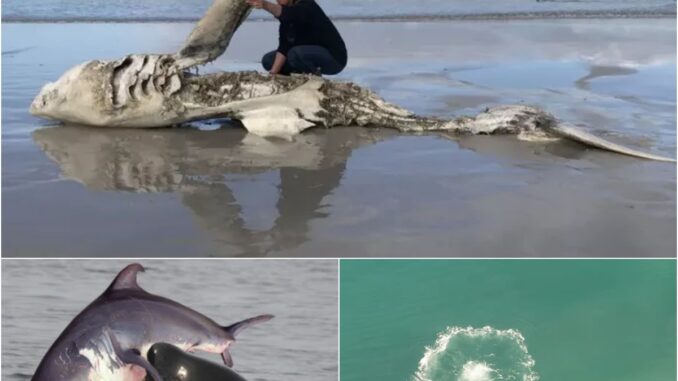
For a decade, the stronghold of great white sharks has been ruthlessly decimated, forcing these ocean predators to flee Gansbaai, South Africa. According to The Guardian, a mere ten years ago, as many as 1,000 great white sharks inhabited this South African bay. Great whites, apex predators themselves, only have one known natural enemy: orca (killer whales). Now, the great white sharks here have vanished, driven away by these formidable marine mammals.
The Vanishing Act: Great Whites Flee Orca Attacks
The first carcass of a great white shark washed ashore in South Africa on February 9, 2017. The 2.6-meter long female shark showed no signs of hooks or nets, ruling out human involvement. Whatever killed it had also vanished. The same pattern emerged with all subsequent great white shark deaths in Gansbaai, Western Cape. Dr. Alison Towner, a marine biologist at Rhodes University, stated, “We had acoustically tagged some of the sharks and then realized that three had moved as far as Plettenberg Bay and Algoa Bay, which is more than 500 km to the east.”
By May, shark numbers had returned to their peak. Then, three more carcasses were found within five days, followed by a fifth in June. For an unusual eight weeks, not a single great white shark was sighted.
Gansbaai boasted a population of 800 to 1,000 great white sharks in the 2010s, but each time one was killed, the sharks in the bay would flee for longer periods and return in smaller numbers. When the sixth carcass appeared in June 2021, they didn’t return for an entire year.
At the time of the initial killings, Dr. Towner was just beginning her PhD on great white shark behavior. “It was eerie to witness the very apex predators I had dedicated my life to studying wash up on the coast,” she said, “and it’s something I will never forget.”
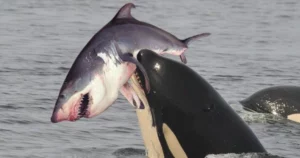
The Prime Suspects: Port and Starboard
Determined to solve the mystery, Dr. Towner and her colleagues performed necropsies on the four most recent shark carcasses. They quickly realized the deaths were linked. All were torn open at the chest, just behind the gills, with surgical precision. Two bodies showed distinctive lacerations. Most strikingly, all four sharks were missing their livers.
All signs pointed to the same culprits: orca.
Two male orcas, known to frequent Gansbaai since 2015, were Dr. Towner’s prime suspects. Local zoologists had named them Port and Starboard, after their distinctive dorsal fins that tilted to the left and right, respectively.
This orca pair had appeared off the Gansbaai coast within hours of each shark death. They had also been observed killing seven-gill cow sharks (Notorynchus cepedianus) in nearby False Bay and voraciously consuming their livers.
Dr. Towner was certain Port and Starboard were the perpetrators. “The only missing element was direct observation of an attack,” she stated.
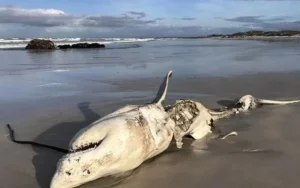
Caught on Camera: The First Visual Confirmation
On May 16, 2022, Christiaan Stopforth was flying a drone over Mossel Bay, approximately 305 km east of Gansbaai, when he captured an extraordinary sight: five orcas attacking a three-meter great white shark, biting between its pectoral fins and tearing out its liver. One of the orcas was Starboard.
Esther Jacobs, founder of the marine conservation charity Keep Fin Alive and one of the first to see Stopforth’s footage, remarked, “It was heartbreaking to witness one of the ocean’s top predators so easily defeated.”
A helicopter crew witnessed three more shark killings that day. Just like in Gansbaai, the surviving great white sharks of Mossel Bay left the area. None returned for 45 days.
Finally, the following June, Port and Starboard returned to Mossel Bay. Jacobs was among those who jumped on a boat to observe them. As they approached the pair, a strong smell of shark liver hung in the air, indicating a recent kill.
Suddenly, a juvenile great white shark appeared, and Starboard lunged at it. Jacobs recalled, “It was horrifying and traumatic. Starboard’s immense power was fully displayed as it held the shark tightly, even as the victim struggled. We watched in stunned silence as it finally disemboweled the shark.”
The shark died in just two minutes, its liver completely consumed. Another carcass washed ashore the next morning, bringing the total number of dead great white sharks to at least three. Today, great white sharks have completely disappeared from Mossel Bay. Jacobs stated, “Since the 2023 incident, they haven’t returned. To my knowledge, there have been fewer than 10 great white shark sightings here in 2024.”
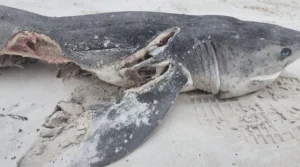
Ripple Effect: The Ecological Impact of Vanishing Sharks
The disappearance of great white sharks from this region also serves as a microcosm of what happens when sharks vanish from the food chain. Great white sharks are often considered the “doctors of the ocean.” This is evident now that they are absent from South Africa, as populations of their preferred prey, Cape fur seals and bronze whaler sharks, have surged in Gansbaai.
The explosion in seal and bronze whaler shark numbers could represent what ecologists call a “trophic cascade,” where the disappearance of a predator affects the food chain downwards, unbalancing the ecosystem.
Dr. Towner noted that the seals, no longer threatened, have become bolder, with some even preying on the critically endangered African penguins.
The absence of sharks can also bring disease: since June 2024, seals in the Western Cape have been infected with rabies, an outbreak that spread to Mossel Bay in July.
Jacobs commented, “In my opinion, if the great white shark population had peaked previously, they could have helped alleviate the rabies situation, as rabid seals would likely be easier targets.”
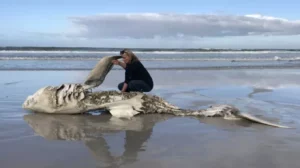
Beyond Orcas: The Human Threat
These devastated ecosystems may grimly reflect the future of our oceans—a future that extends beyond two orcas. While Port and Starboard offer insight into how quickly an ecosystem can shift, the far greater extinction threat all sharks face is humans.
Recent studies by Professor Nicholas Dulvy at Simon Fraser University in Canada have concluded that human activities, particularly overfishing, are accelerating the global extinction of sharks and rays.
“After more than a decade of research, we now know that global shark populations have halved since 1970,” said Dulvy. Overfishing kills over 100 million sharks annually, and more than a third of shark species are threatened with extinction.
Without effective fishing regulations, the ecological damage seen in South Africa could occur on a much larger scale. Jacobs observed, “The future for sharks will be very bleak if overfishing continues.”
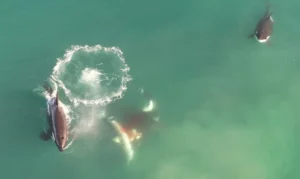
Dr. Towner reiterated the shark conservation recommendations from Dulvy’s report: “Strengthening international policies to combat overfishing, expanding marine protected areas, and promoting sustainable fishing practices are key actions. Of course, that’s if people listen to the science.”